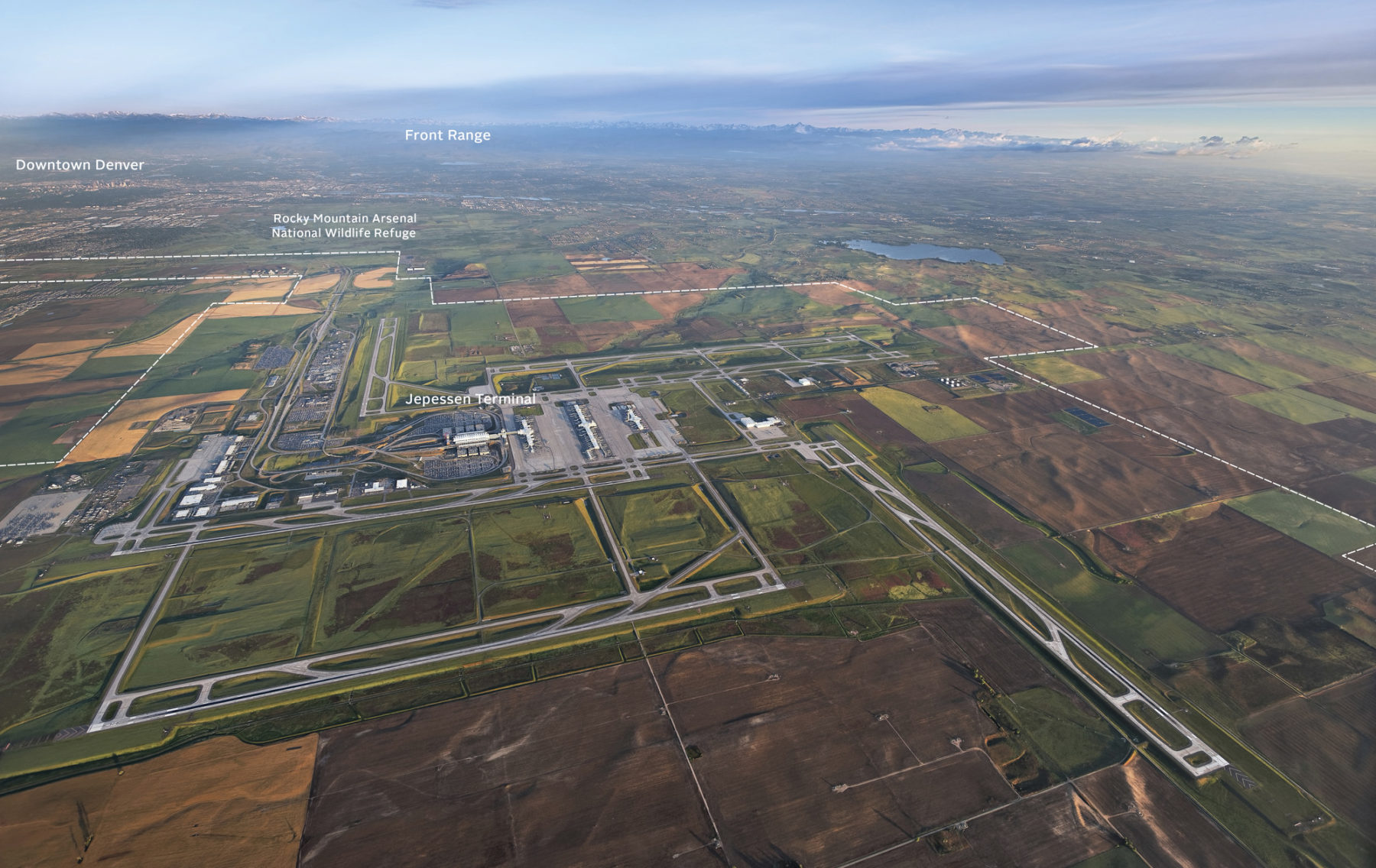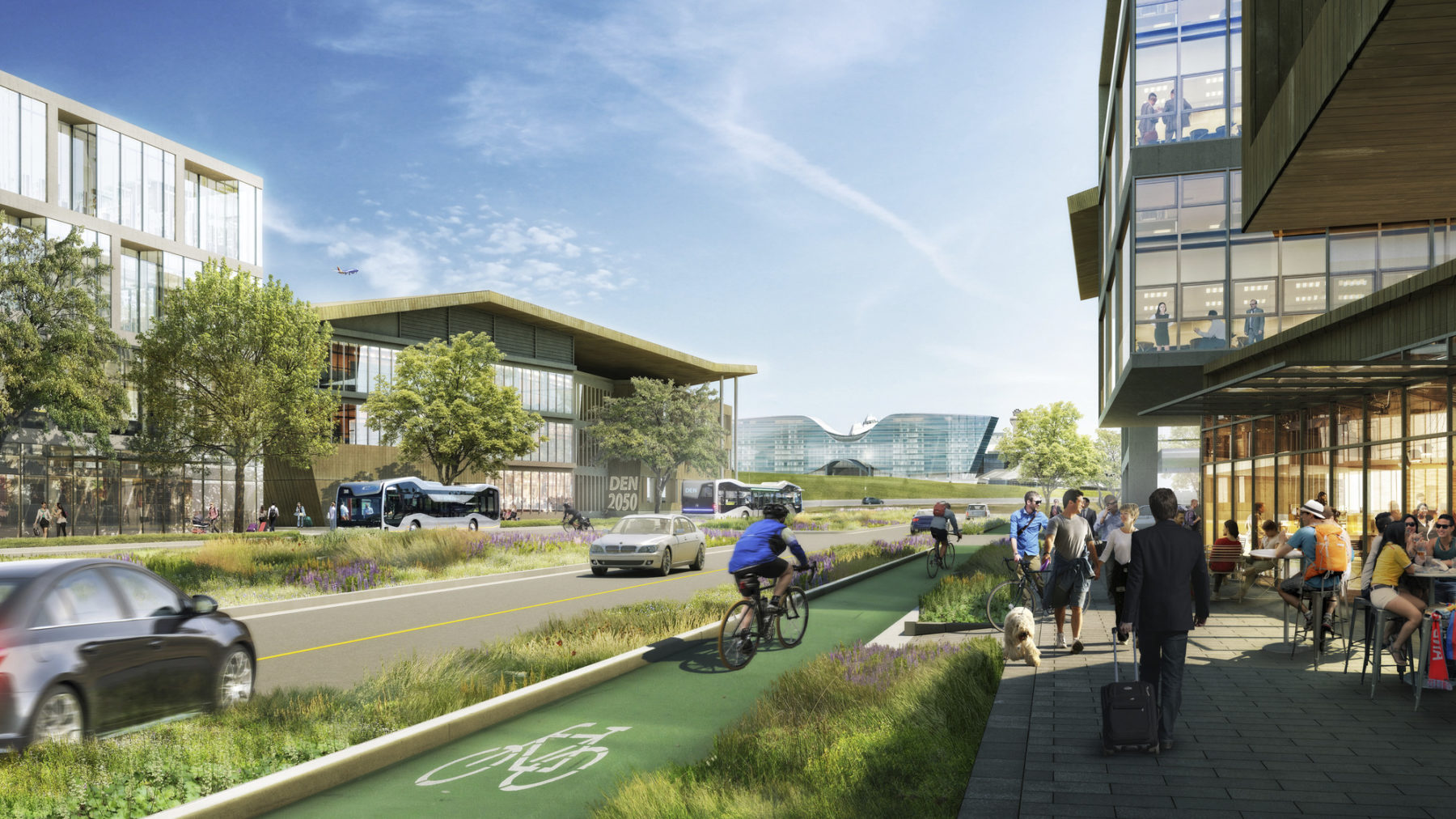Denver’s Airport City

 Sasaki
Sasaki

For the regular air traveler, this is a familiar sight: a vast patchwork of colored landscape, seams of streets and fences dividing one field of color from the next, extending in every direction until the horizon blurs. And yet, no matter how many times one sees the earth from this vantage point, it never gets old. The moment this aerial patchwork pattern starts to resemble a quilt of colored fabric—square acres reading as mere square inches—is the moment a flyer becomes acutely aware of their immense distance from the earth and the wonder of air travel.
What if people on the ground were to capitalize on this precious moment of realization and awe? What if that quilt of color were actually deliberately woven with the viewer’s experience in mind? This is one idea getting traction with DEN Real Estate, the real estate development group at Denver’s International Airport (DEN). As DEN refines its vision of what a global airport—and airport city—should be, they are thinking through the entire user experience, from first impressions in the air or on the ground, to everyday experiences visiting and working at DEN, to a passenger’s last moments on the jetbridge before boarding a flight.
Cultivation of airport cities is an emerging development strategy shaped by urban planners, civic leaders, airport executives, and academics. One scholar on the subject, John Karsada, contends great cities have always sprung up around transportation hubs and the cities of our future will expand around airports, growing into what he dubs the aerotropolis: “The three rules of real estate have changed from location, location, location, to accessibility, accessibility, accessibility. There’s a new metric. It’s no longer space; it’s time and cost. And if you look closely at the aerotropolis, what appears to be sprawl is slowly evolving into a system reducing both. It’s here where we see how globalization will reshape our cities, lives, and culture.”[i]

For years, DEN has excited those within aviation, civic, business, and development circles, but until recently did not have the legal basis to engage fully in non-aviation real estate development. That is, until 2015, when DEN and its neighbors amended an intergovernmental agreement (IGA) allowing DEN to move forward with development plans that will benefit both the airport and surrounding communities. With the IGA in place, DEN engaged Sasaki to lead the creation of the Denver International Airport Strategic Development Plan for the airport’s non-aviation land holdings.
In a forward-looking move, DEN’s founders amassed some of the largest land-holdings of any airport in the world. In fact, it is second only to Dubai’s International Airport based on sheer footprint. For a sense of scale, DEN has greater acreage than the entire city of Boston. Today, DEN is the primary economic engine for the state of Colorado, generating more than $26 billion for the region annually, but with strategic investment it could multiply its impact. With a recently opened rail line that connects the airport to downtown; a rapidly growing talent pool and hot business and real estate climate in Denver; a geographically advantageous position; and plenty of land to work with; DEN has all the raw inputs to advance as a dynamic airport city of global significance.

The DEN Strategic Development Plan creates a roadmap for transforming non-aviation airport land into a series of vibrant development districts that serve local, national, and global commercial and institutional purposes. The East Approach district [pictured above] connects directly to the airport terminal and the recently-opened Westin hotel and conference center
Realizing the airport’s development and placemaking potential will require attracting anchor tenants and a host of complementary uses to enhance DEN as a destination. Working with Sasaki’s planning and design team, DEN is cultivating four primary development districts, each with its own signature identity to attract global businesses and institutions and establish a memorable, sustainable experience for the competitive benefit of airport, the city, and the region. The districts accommodate a spectrum of uses, such as office, research and development, education, advanced manufacturing, agribusiness, retail, and hospitality that will leverage airport adjacencies and benefit both the airport and surrounding communities.
DEN acts as both municipal regulator and owner, allowing flexibility in responding to changing market trends. For this reason, the plan offers a long-range vision and strategic roadmap for decision-making. “Realizing the vision will depend on land use, mobility, and landscape strategies to ensure all phases of growth result in standalone, but interconnected districts with vibrant, world-class urban character,” the Strategic Development Plan states.
One of DEN’s greatest assets, beyond its aviation operation and the scale of its land holdings, is the Colorado landscape. With wide-open grass plains that act as grazing lands for bison, long-range vistas of the Rocky Mountains, and a temperate climate that routinely yields sunshine-drenched days, this region has exceptional natural assets to leverage in the cultivation of a memorable experience for all visitors. The plan’s landscape strategy highlights the airport’s dramatic position within the Colorado landscape from many vantage points and integrates development into this broader context. Additionally, the airport landscape contributes ecosystem services including carbon sequestration, groundwater recharge, pollinator habitat, and serving as a seed bank for native grasses and wildflowers that respond to the changing seasons.
Unique to this plan is the consideration given to different scales of the landscape experience, capitalizing on the many ways airport visitors traverse the airport and surroundings. By foot, bicycle, car, train, or plane—each mode of transport provides a distinct perspective and specially-crafted experience.

For those in transit, at 65 mph, the unobstructed landscape will focus on geographic features viewed from a distance. At slower speeds of 40 mph, for entry and exit of the airport, transitional landscapes will display artful interpretations of utilitarian landscape elements to highlight local heritage. For those transitioning into immersive landscapes on foot, interactive elements like installations and exhibits will encourage lingering, interaction, and education. Lastly, the aerial landscape viewed at takeoff and landing will feature seasonal changes and crop rotations to yield dynamic expressions of the changing regional landscape.
One of the critical factors bolstering DEN’s real estate vision is Mayor Michael B. Hancock’s economic development initiative, the Corridor of Opportunity, which follows the recently opened commuter rail line between downtown Denver and the airport. Real estate development at DEN reinforces the Colorado region’s growth and Denver’s focus on smart jobs development along the Corridor of Opportunity. Plans are completed and underway for a number of transit-oriented developments along the corridor. These developments will draw businesses, workers, residents, and visitors between the airport and Denver’s downtown in a continual flow of people, ideas, and currency.

“The four development districts contribute to creating a new ‘experience’ in which DEN transforms from an airport moving passengers and cargo into a new type of airport urban district that makes DEN a destination for connection, convergence, and collaboration. It will be a new opportunity to serve a full spectrum of Denver citizens and Coloradans and draw new talent from the world over as DEN transforms into a dynamic employment district that anchors the region,” says principal in charge on the project, Fred Merrill, FAICP. “I believe DEN is poised to lead American airports into this next chapter in urban development. With vision and community support, DEN and its neighbors are redefining what it means for Denver to be a contemporary American airport city and that ambitious spirit is energizing for us as a planning team, and for the many stakeholders involved in this work.”
The DEN Strategic Development Plan will be phased, with initial focus on approximately 1,000 acres along the airport’s main access road, Peña Boulevard.Check back soon for the full report and updates on implementation.
[i] John D. Karsada, Aerotropolis, (New York; Farrar, Strauss and Giroux, 2011), p. 10